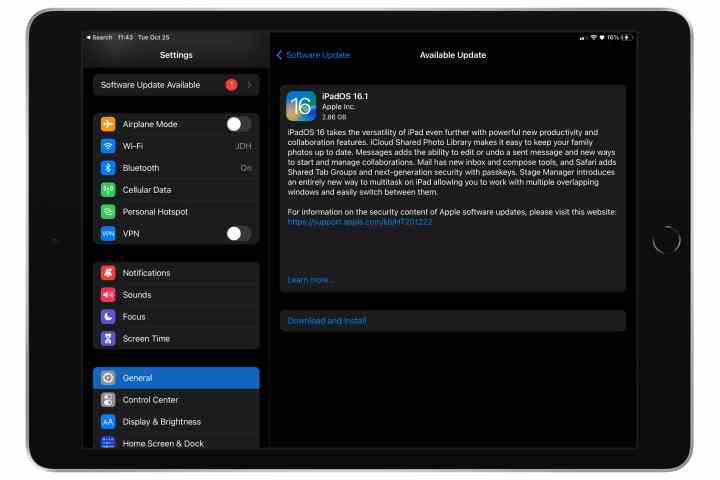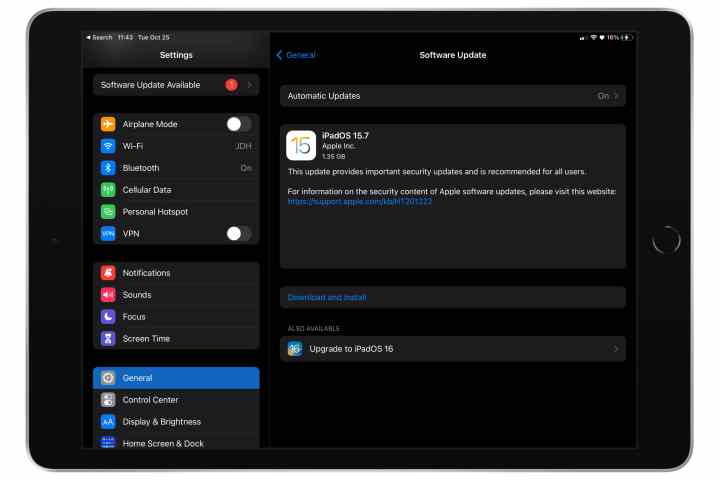
After being delayed for over a month, Apple has finally released iPadOS 16, the next-generation operating system for its tablets. This major iPadOS update introduces some cool and exciting new features, including a new stage manager that promises a more productive multitasking experience, improved collaboration, and a renewed focus on gaming.
Apple's first significant iPadOS release for 2022 comes as iPadOS 16.1 to keep it aligned with Apple's iOS 16.1 update for the iPhone. Much like iPadOS 13.1, when Apple first split iPadOS off from iOS three years ago to become its own operating system, there is no iPadOS 16.0.
When Apple unveiled iPadOS 16 at its Worldwide Developers Conference (WWDC) in June, it was likely aiming to release iPadOS 16.0 in September alongside iOS 16. However, by last August Apple had apparently decided that iPadOS 16 needed a little more time in the oven, confirming that it would be releasing it as iPadOS 16.1 in October.
Nevertheless, it's here now, and the good news is that with the extra delays you can be more confident that you won't be jumping into a hot mess by upgrading as Apple has taken the additional time necessary to ensure that it will deliver a more polished experience to its customers. Here's how to get ready for and install the latest major iPadOS update.
Ensure your iPad is compatible with iPadOS 16
The first thing you'll want to check before you begin is whether your iPad model is compatible with iPadOS 16. While Apple does its best to support its older tablet models, one or two still usually drop off the list each year due to the more demanding requirements of each major iPadOS update.
Note that you won't be offered the iPadOS 16 update at all if your iPad isn't compatible with it, so you don't need to worry about installing it by mistake. Still, there's no point in proceeding if your iPad can't run iPadOS 16 in the first place.
This year, it's the iPad Air 2 and iPad mini 4 that have been left out of the party. Considering that these models were released in 2014 and 2015, respectively, that shouldn't be much of a surprise; if anything it's a testament to the longevity of Apple's support that an eight-year-old tablet could even run iPadOS 15.
Apple hasn't drawn the line based solely on the age of its tablets. If you have an original 2015 12.9-inch iPad Pro, you'll still be able to update it to iPadOS 16. Beyond that, any iPad released since 2016 supports iPadOS 16.

Back up your iPad
It's always a good idea to have a current backup of your iPad before installing a new iPadOS release, especially when it's a whole new generation of Apple's operating system rather than a smaller maintenance release. While Apple's iPadOS updates usually go smoothly, there are never any guarantees, so a backup ensures you have something to fall back to in the unlikely event that you run into a problem.
You can find the instructions on how to do this in our article on How to back up an iPad.
We also recommend making an additional backup to your Mac or PC in case you need to return to iPadOS 15 later on. You can't restore a backup made from a newer version of iPadOS onto an iPad running an older version, and iPadOS backs up your iPad to iCloud automatically every 24 hours. Only the three most recent iCloud Backups are retained, so it won't take long for your iPadOS 15 backups to be pushed out of the rotation. Backing up to your computer will ensure you have a backup available in case you have to restore to iPadOS 15.

Install iPadOS 16
Once you've backed up your iPad, you're ready to jump in and install iPadOS 16.1.
Step 1: Open your iPad Settings app.
Step 2: Select General.
Step 3: Choose Software update. After a few seconds, iPadOS 16.1 should appear.
Step 4: If you haven't already updated to the latest version of iPadOS 15, such as iPadOS 15.7, you'll be offered that instead. In that case, select Upgrade to iPadOS 16 at the bottom of the Software Update screen to choose to install iPadOS 16.

Step 5: Select Download and install to begin the process.
Step 6: Tap Agree when the Terms and Conditions window appears.

It may take anywhere from a few minutes to an hour or more to download iPadOS 16, prepare it, and then install it on your iPad. After that process completes, your iPad will restart and take you through a series of welcome and setup screens, similar to those you'll see when first updating to a public release.



